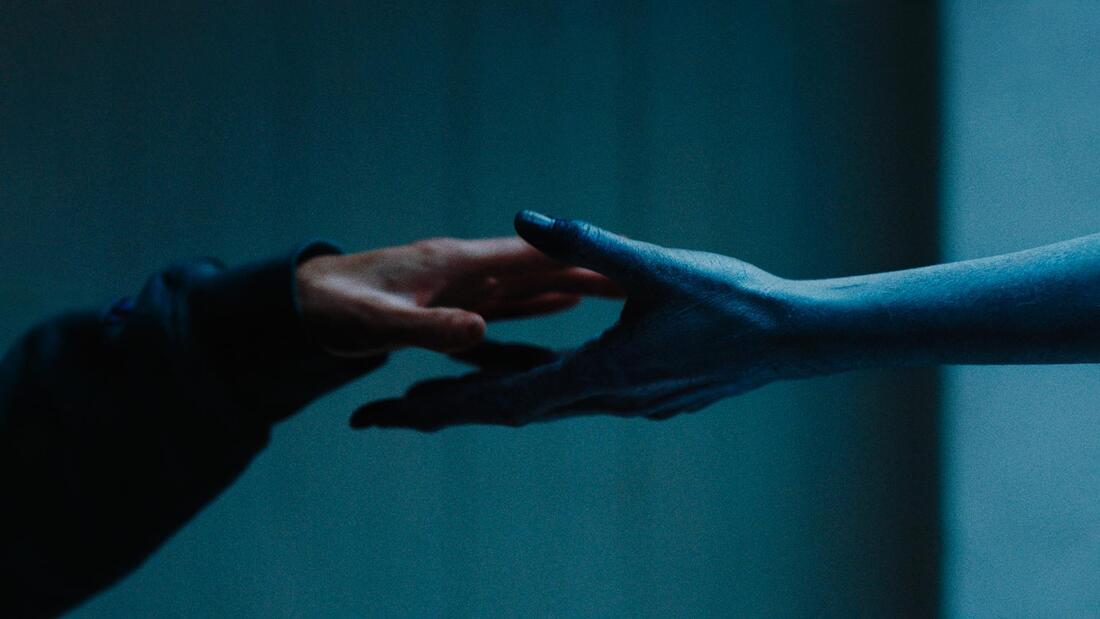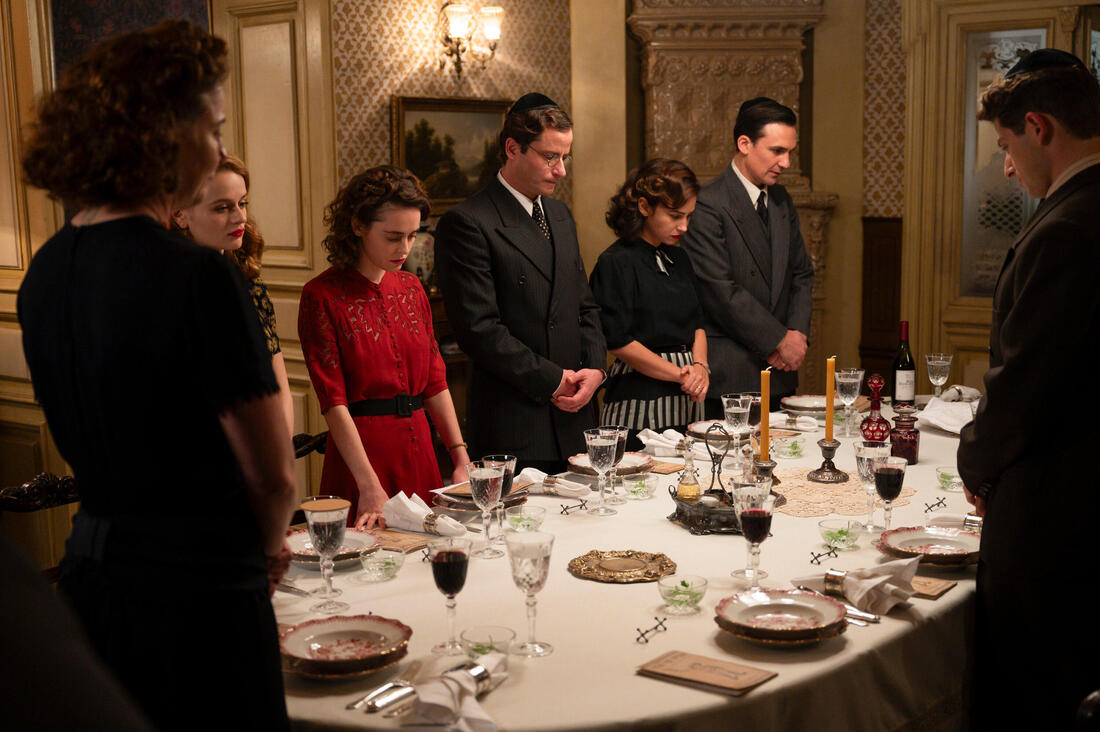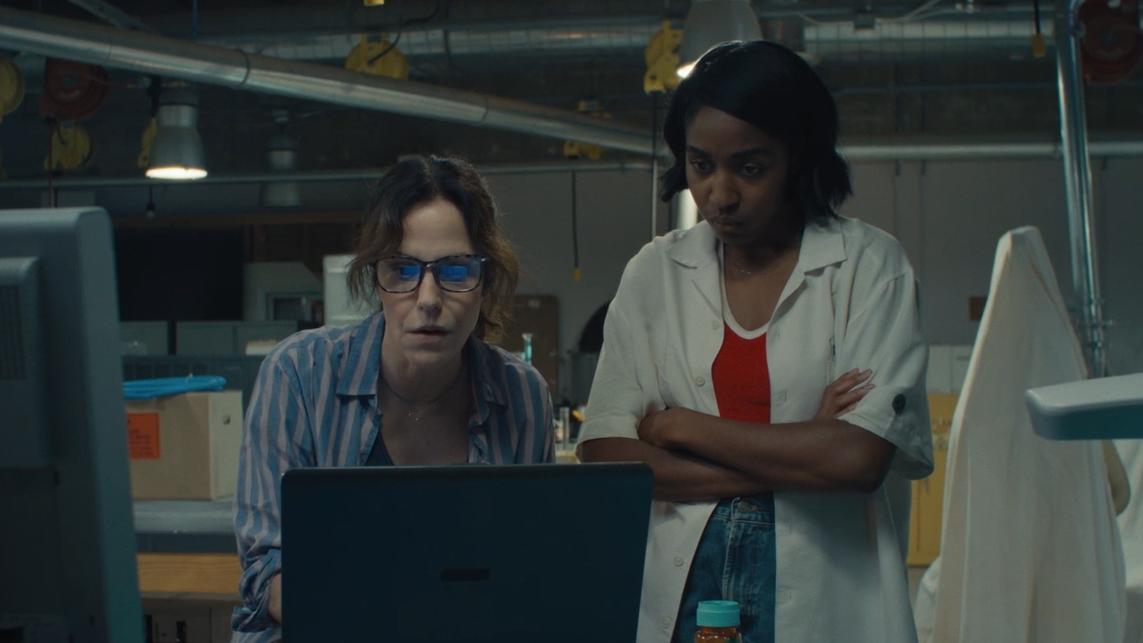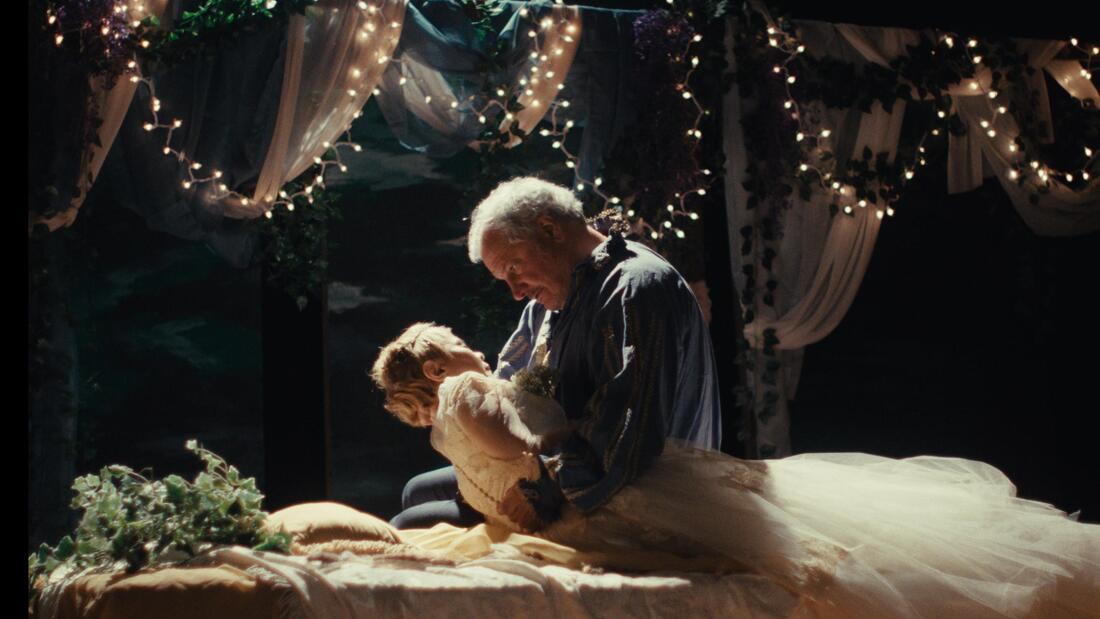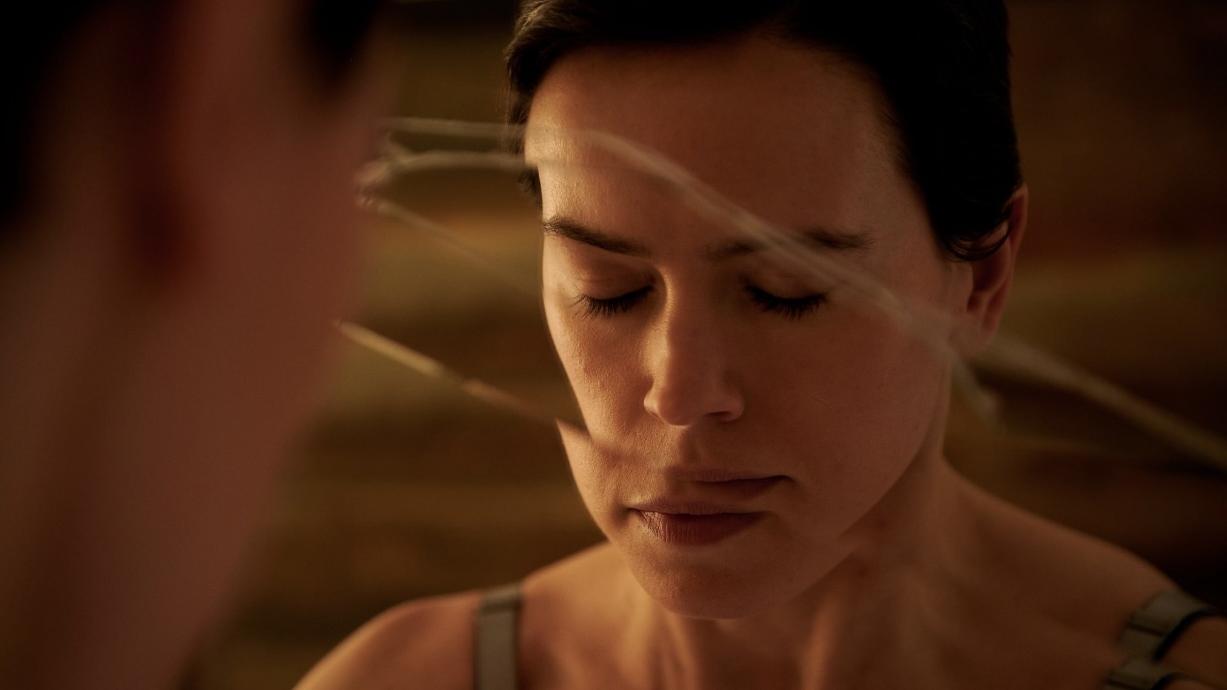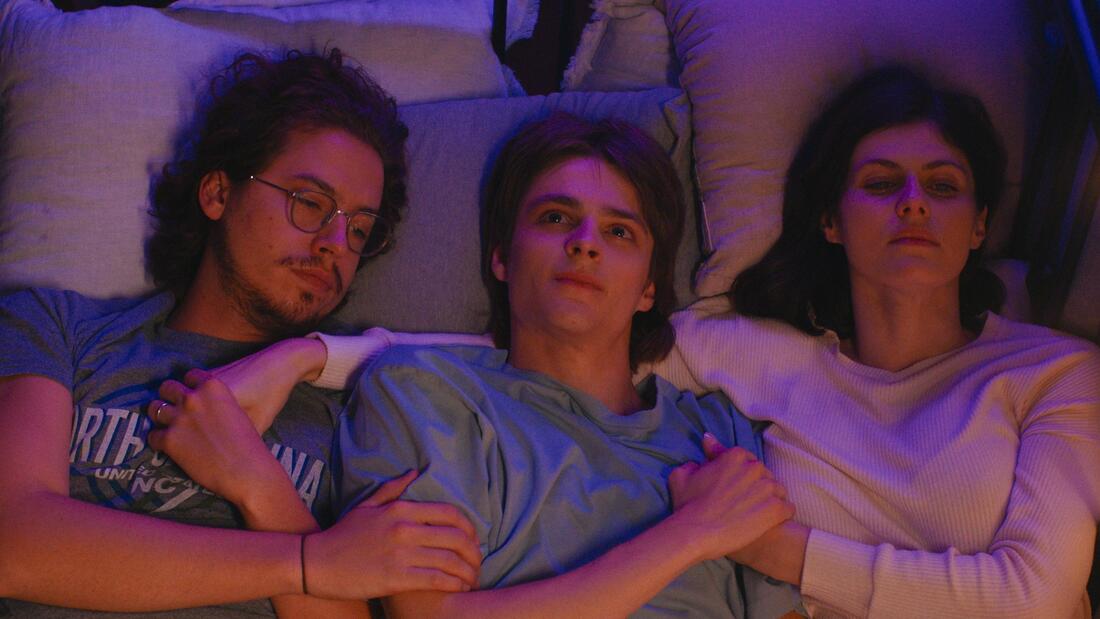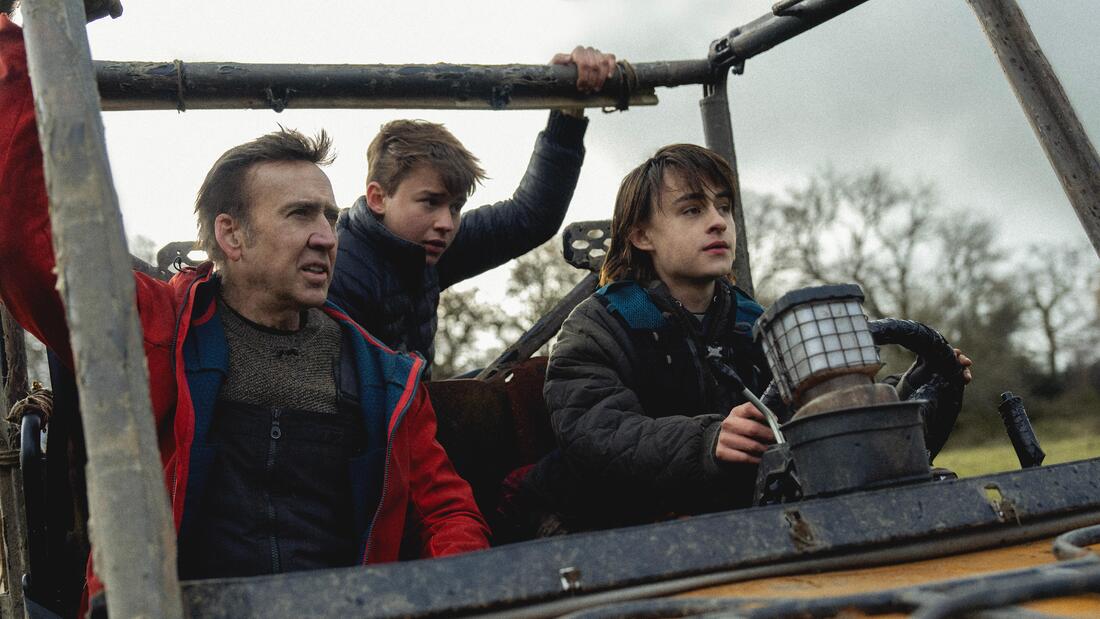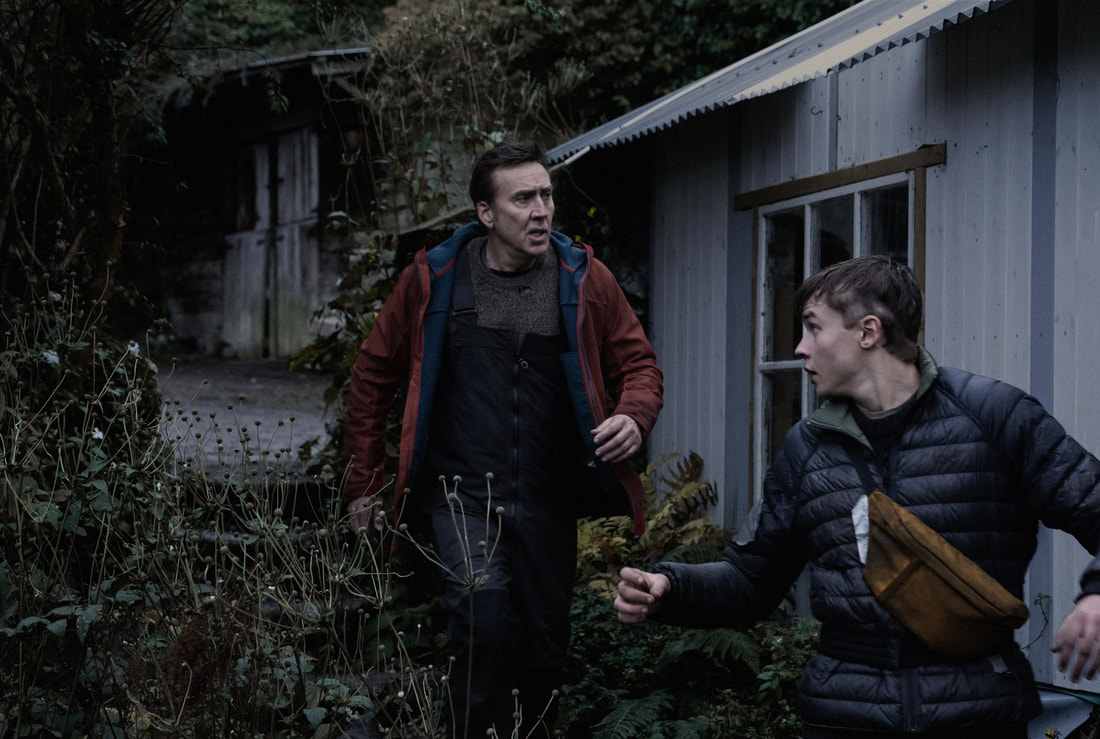|
Review by Sean Boelman
In the horror genre, a good story is often just as important as being scary. However, there are some times when the atmosphere is so strong that it can carry a weak script. That’s the case with Benjamin Finkel’s Family, a genuinely unsettling film that only works if you overlook its glaring writing issues.
The movie follows a young girl whose well-intentioned prayers for her dying father become something much more sinister. To put it nicely, the plot is utter nonsense. A lot of things happen, and the film moves from point A to point B, but the motivations and arcs are illogical. But despite this, it’s a ton of fun to watch. Trying to make sense of what the movie has to say is even more in vain. The themes are incredibly underdeveloped. In many ways, it feels like it’s trying to explore the concept of familial trauma a la Hereditary, but Wilson’s mother character isn’t developed enough for this to work. At other points, it seems like a more straightforward commentary on grief, and this angle simply isn’t interesting. The character development isn’t much more intriguing. The protagonist has an ailing father, a (questionably) abusive mother, and a rabbi grandfather she turns to for guidance in the face of supernatural happenings — all archetypes that are thoroughly worn. Worse yet, the protagonist lacks much of a personality of her own. Still, for as lackluster as his script can be, Finkel is one hell of a director. He manages to create a consistently engaging and often downright chilling atmosphere here. It’s a loud, in-your-face horror flick with a blaring score, aggressive imagery, and many jump scares. But in many ways, it’s effective at achieving what it sets out to do. Much of the film’s success can also be attributed to supporting actress Ruth Wilson, who hams it up in all the right ways. Wilson takes the movie incredibly sincerely, making the performance all the more intimidating even though some of the things she does are deeply unserious. The rest of the small cast is fine, but this is almost entirely Wilson’s show. The film is impressive visually, if not entirely original. A lot of the visual symbolism can be seen as a carbon copy of other movies that came before it, with Annihilation being the most obvious example. However, Elisha Christian’s cinematography and Olivia Peebles’s production design are very formally accomplished. Family is a jumbled mess of a movie, and trying to figure out what’s happening or — more importantly — why is futile. Still, Benjamin Finkel does such a good job with the atmosphere, and Ruth Wilson’s performance is so incredible that the film works regardless. Family screened at the 2024 SXSW Film Festival, which ran March 8-16 in Austin, TX. Rating: 3/5
0 Comments
Review by Sean Boelman
Making a movie about a “current” topic like cryptocurrency is a challenging prospect. It could be incredibly prescient, or it could feel immediately dated. That’s the least of the problems with Cutter Hodierne’s Cold Wallet, though. Despite the endorsement of iconic and talented crime filmmaker Steven Soderbergh, Cold Wallet is just another run-of-the-mill B-movie — and not a very good one at that.
Cold Wallet follows a group of people who, after losing their life’s savings in a cryptocurrency scam, decide to take things into their own hands and steal the money back from the man who screwed them over. Despite this intriguing premise, this is about as vapid as they come, with nothing of artistic merit and little of entertainment value. The film is mainly held back by its dialogue, which is frankly atrocious. One line in the movie said with a completely straight face, “You have a missed call from a guy named Guy. Who is this guy?” sticks out as an example of John Hibey’s screenplay lacking the basics, not just of screenwriting but also of the English language. It’s like they didn’t even read the script through to see if everything made sense. Speaking of not making sense, the character motivations are completely illogical. You have a father trying to provide for his family, a rich billionaire trying to protect his wealth, and two people who are along for the ride, having lost their money. It’s basic enough. However, the third act tries to pit them against each other in different ways, and the dynamics it attempts simply do not work. The only person in the cast who manages to make something of their role is Raúl Castillo (Army of the Dead), and it’s hard not to feel bad for the actor. He’s trying to bring his usual charm and gravitas, but the role is so detestable by the end that he can’t save it. Josh Brener (Silicon Valley) gives what might be the laziest performance ever given in cinematic history. And Tony Cavalero (The Righteous Gemstones) is wasted on a role that fundamentally misunderstands its talents. One might be able to forgive Cold Wallet if its production values were at least sleek and energetic. It is “presented” by Steven Soderbergh, after all, so one might hope this would be an Ocean’s-esque crypto heist movie. Those hopes would be in vain, as the film has all the dour qualities of every crappy straight-to-VOD B-movie you’ve ever seen. Indeed, Hodierne’s second feature does not work on any level. As a home invasion thriller, it’s not tense; as a heist movie, it’s not exciting; and as a Robin Hood-esque revenge tale, there’s no compelling hero to root for. If anything, you’re watching to see the worse people get their comeuppance, but it doesn’t even deliver satisfying carnage in that regard. The fallacy of Cold Wallet can probably be best summed up by a promotion the filmmakers ran timed to the festival premiere. The film is unquestionably a cautionary tale about the dangers of crypto and obsession with these fads. Yet despite this, attendees were given the chance to enter a contest to win Bitcoin. If this sounds hypocritical, that’s because it is — but it doesn’t even touch the level of idiocy present in the script. Cold Wallet screened at the 2024 SXSW Film Festival, which ran March 8-16 in Austin, TX. Rating: 1.5/5
Review by Sean Boelman
It’s hard to make a bad movie or show about the Holocaust because these stories tend to speak for themselves; however, it’s also challenging to make a great one because of how high the bar has been set. Hulu’s We Were the Lucky Ones has high production values and an incredible story but never breaks out of the mold of the Holocaust drama to deliver an experience that stands out.
Based on the novel by Georgia Hunter, the show tells the story of a family of Polish Jews during WWII as they are separated from one another and fight to survive and reunite. Inspiring Holocaust stories are a pretty safe bet for a crowd-pleaser, but We Were the Lucky Ones arguably plays it too safe, settling for bland inspiration rather than actually provoking viewers to reflect on the atrocities and devastation they are seeing. Part of the issue is that the show cannot juggle its multiple storylines. Jumping between the different siblings’ stories could have created a compelling juxtaposition, comparing their various paths to survival; instead, it feels anticlimactic. The structure feels more out of the need to set up cliffhangers than it does any thematic planning. Of course, as is often the case with shows following this structure, some storylines are more engaging than others. However, what’s unfortunate about this one is that there are even lulls in the individual storylines. Although the periods of (relative) calm are understandable within the context of the story, they aren’t very cinematic, dragging the pacing to a halt.
One of the more noticeable mediocrities of We Were the Lucky Ones is its cast. Joey King and Logan Lerman, the two main stars, are passable, but lack the humanity in their performances that makes this genre resonate. King gets a few flashy moments where she shines, but struggles with the quieter moments in the rest of her role. Surprisingly, the less well-known Henry Lloyd-Hughes is the most impressive of the leading trio when it comes to the subtler parts.
Still, by the time you reach the last episode, you will be unquestionably moved by the level of perseverance these people have shown in the face of adversity. Although the message that love (in this case, of the familiar variety) conquers all isn’t groundbreaking, it’s an important reminder in a time increasingly defined by division and vitriol. The one area in which We Were the Lucky Ones unequivocally excels is its production values; however, that is the bare minimum for a prestige period drama like this. The production design, costuming, and visual effects are all fairly impressive in how they create the show's setting — especially considering how international it is compared to other entries in the genre. In most ways, We Were the Lucky Ones is like virtually every other run-of-the-mill Holocaust drama you have seen — for better or worse. It’s certainly moving, although any piece of media that tells a story like this should be; it just puts in the minimum effort to get its emotional response. We Were the Lucky Ones streams on Hulu beginning March 28 with three episodes, with new episodes streaming subsequent Thursdays. All eight episodes reviewed. Rating: 3/5
Review by Sean Boelman
Although Brazilian-American filmmaker Bernardo Britto has already made his feature debut, he’s arguably more known for his work in animated shorts. Britto’s sophomore feature, Omni Loop, shares some of the quirky sensibilities of his animated work but also has an extremely strong emotional core, allowing it to resonate strongly.
The film follows a middle-aged woman with a rare condition: a black hole in her chest. This sets off a perpetual loop, forcing her to relive the same week over and over again — the “last” week of her life — until she sets out on a quest to understand why she got there. Like much of the sci-fi genre, Omni Loop isn’t subtle with its existentialist message, but it’s incredibly poignant either way. The first act is pretty much what you would expect from a high-concept sci-fi comedy: the characters get into hijinks as the rules of the situation are explained. Britto wisely makes the decision not to go too in-depth into the logistics of the loop, trusting the audience and their suspension of disbelief. The result is some solid laughs. As is often the case with movies with this premise, the initial novelty wears off rather quickly. The pacing slows down significantly, and the story takes what — at least at first — seems to be a tangent. While this could cause some viewers to check out of the story, this is the type of movie where the pieces all make sense once you can see the entire picture (even the oddly-shaped ones in the middle act). The last third of Omni Loop ties everything together in a way that’s wonderfully poignant and emotional. Although the end of the film is somewhat predictable, it feels like such a natural conclusion to the story we watched unfold that it feels entirely satisfying on an emotional level. Britto also knows how to milk the most possible emotion out of this moment. What’s most surprising about Omni Loop is just how good Mary-Louise Parker’s performance is. In many ways, it feels like a “born for this” type of role because of just how well she slides into the role. Ayo Edibiri is fine in her supporting role, often funny even, but Parker has such a gravitas of an “I didn’t know she had this in her” variety that she commands the screen. Visually, Omni Loop is somewhat straightforward but mostly effective. It’s not the type of sci-fi movie that’s heavy on visual effects and production design — Britto instead wants to immerse us in the (very hot, very crowded) real world of Miami, Florida. It’s a wise decision, as it allows Britto to make the story feel more grounded despite the absurdity of the premise. At first, one might think that Omni Loop suffers from pacing issues. However, Bernardo Britto’s sophomore feature is very intricate — and patient — in nature. He takes his time letting the story and themes fall into place, but when they do, it’s profoundly moving in more ways than you could hope for. Omni Loop screened at the 2024 SXSW Film Festival, which ran March 8-16 in Austin, TX. Rating: 4.5/5
Review by Sean Boelman
After premiering at the Sundance Film Festival to raves, filmmakers Kelly O’Sullivan and Alex Thompson’s Ghostlight made a stop at SXSW, where their debut Saint Frances premiered in 2019 to win the top prize. Poignant and emotional, Ghostlight is flawed, but those rough edges are part of what makes it feel so profoundly humanistic.
In the film, a grieving construction worker finds solace in the most unexpected of places — with a community theater troupe putting on a production of Romeo and Juliet. However, as he begins to dive into the art and craft of acting, he finds similarities between the drama in the play and his own life. One of Ghostlight's strongest aspects is its cast, and no one stands out quite as much as Keith Kupferer. Kupferer has a pretty robust career as a background and character actor, which is exactly what a role like the lead in Ghostlight calls for. He has an everyman quality about him that allows the character to be intensely sympathetic and relatable. However, there’s a poignant, subtle emotion to his turn that really shines through. Although Kupferer is the cast's clear high(ghost)light, the rest of the ensemble isn’t too shabby, either. The most recognizable face is probably Dolly De Leon, who is going strong after her breakout in Triangle of Sadness. Her performance is charming and tender — maybe not what one would expect, but incredibly powerful nonetheless. Other memorable supporting turns come from Katherine Mallen Kupferer (who plays her actual father’s daughter; no wonder they have great chemistry) and Tara Mallen. The problems with the film come in with its dialogue and editing. Much like a theatrical production, Ghoslight is full of exposition — failing to trust the audience to come to their own inferences regarding the conflict. There’s no denying the power of some of the film’s moments, but others feel so on the nose that they nearly ruin the narrative's authenticity. Additionally, the film’s scenes are cut in a way that makes it feel like there is little to no breathing room. It falls victim to the editing problems that affect many dialogue-heavy dramas, namely cutting immediately after lines are delivered or actions end. Each scene feels like it could use at least 2 or 3 more seconds to sit with the emotion; though, with a runtime of an hour and 50 minutes already, this might have caused the film to feel a tad bloated. Still, O’Sullivan’s script succeeds in giving the audience a set of incredibly sympathetic characters. Although the meta-narrative structure of the film isn’t exactly innovative (Drive My Car recently did the same thing incredibly well with Chekov instead of Shakespeare), O’Sullivan keeps the film feeling authentic and never veers into gimmicky territory. Ghostlight has many incredible elements that make it a stirring, emotional watch. Although some aspects of the film could have been refined, like its dialogue and editing, the performances are so phenomenal that they absolutely speak for themselves. Ghostlight screened at the 2024 SXSW Film Festival, which ran March 8-16 in Austin, TX. Rating: 3.5/5
Review by Sean Boelman
Star Wars sequel trilogy actress Daisy Ridley has discussed how she’s struggled to get work after the end of her franchise contract, so why not create work herself? That’s what she did with Magpie, an erotic thriller written by her husband, Tom Bateman (who’s also an actor, making his screenwriting debut here), based on an original idea by her. While a tad generic, Magpie is a great acting showcase for Ridley and is undeniably fun to watch.
The film follows a seemingly happily married couple whose daughter is cast in a film production alongside a controversial budding starlet, causing an unexpected rift in their relationship. Although Bateman’s script thinks it’s smarter and more original than it is, it’s still effectively built within its tropes. The cast of the film is excellent. All three leads — Ridley, Shazad Latif, and Matilda Anna Ingrid Lutz — are bringing their A-game. Latif, in particular, stands out, playing the sleazy but charming protagonist troublingly well. However, Ridley is an excellent foil to Latif, giving a similarly two-faced turn, albeit in the opposite direction. Lutz is just incredibly lovable and sympathetic. That being said, one of the things that doesn’t really work about Magpie is its character development. Ridley’s character isn’t given enough personality to justify the actions of Latif’s character, who is, therefore, maybe a bit too sympathetic. Lutz’s character is objectified and shallow but not quite enough to be satirical. Furthermore, although Magpie was made well before Saltburn came out, the comparisons are sure to be inevitable — it’s a British thriller with an ending reveal that spells out everything for the audience with absolutely no ambiguity. Still, with a tight 90-minute runtime, the film has an undeniable narrative momentum that will draw viewers in. Don’t get me wrong, it’s an enjoyable ride. Watching Ridley and Latif go back and forth is entertaining, much like it was fun to watch Daniel Day-Lewis and Vicky Krieps in Phantom Thread. However, the film does feel very shallow. The commentary on obsession is nothing new, and while it shows a lot of potential in exploring themes of objectification and the toxicity of online culture, these are tangential to the story. Director Sam Yates doesn’t bring much of a distinct style to the film, but he is able to lend the film an effective atmosphere. This is the type of film set in haute couture that you almost expect to be a little more glamorous and flashy than it is, but in many ways, it’s down and dirty. A few scenes are very kinetically edited in a way that will keep viewers on their toes. Magpie pales in comparison to many of the other erotic thrillers that came before it, but it’s a ton of fun to watch nonetheless. Still, if I were a marriage counselor, I’d knock on Tom Bateman and Daisy Ridley’s door. For the couple to come up with something like this, something must be going on between them. Magpie screened at the 2024 SXSW Film Festival, which ran March 8-16 in Austin, TX. Rating: 3.5/5
Review by Sean Boelman
Coming-of-age stories are a dime a dozen, and recently, we have seen a wave featuring queer protagonists. I Wish You All the Best doesn’t break the formula narratively; however, it does defy expectations in other ways, delivering a deeply empathetic portrait of growing up from a diverse and often underrepresented perspective.
The film follows a nonbinary teen who, after being kicked out of the house by their parents, moves in with their estranged adult sister, setting off a journey of mutual discovery and understanding. Based on a novel by Mason Deaver that’s only a few years old, I Wish You All the Best is a very comfortable entry in its genre, but does some things notably well. Clocking in at just over 90 minutes, it often feels like the movie is rushing through many beats. The arcs move incredibly quickly, with characters changing in what feels like the blink of an eye. However, the script has several remarkable moments. These scenes are wisely given the time they deserve and carry much of the film. Yet, though the movie adheres to many of the familiar tropes of the coming-of-age genre, it does it with a unique perspective and level of representation that makes it feel refreshing. Trans filmmaker Tommy Dorfman adapts this story of a nonbinary teen with a necessarily subtle hand. It feels like a queer story that just is — not something that’s meant to be flashy or showy. It’s invigorating to see a film about the queer experience that is as hopeful as this. Although the movie doesn’t shy away from the darkness, it also shows the support the character receives from others. It’s a reminder that, with kindness, the world can be a better, much more compassionate place. The cast also deserves a lot of props for elevating I Wish You All the Best beyond the usual level of the coming-of-age drama. Alexandra Daddario has never been better than she is here, showing a range you might not expect from the actress. Cole Sprouse plays more to type — quirky and awkward but charming — but his performance works well. Lena Dunham also has a supporting role, and while it’s much smaller, she gets a few scenes that either get really hard laughs or a few tears. However, the real discovery here is Corey Fogelmanis. Calling him a “discovery” might be unfair because he’s had a decade-long career as a child star — mostly in young-adult television — but this role has breakout potential and star power. Fogelmanis brings a necessary vulnerability to the character, even during the more conventional or melodramatic beats, that keeps the film thoroughly sympathetic. I Wish You All the Best stands out in a crowded coming-of-age genre thanks to its distinct perspective and authentic approach to these common themes and tropes. Many young people are going to feel heard, thanks to this movie, and that makes it an essential work of cinema for the current generation. I Wish You All the Best screened at the 2024 SXSW Film Festival, which ran March 8-16 in Austin, TX. Rating: 4.5/5
Review by Sean Boelman
Grand Theft Hamlet is the type of documentary with an insane, bizarre concept that seemed destined to divide audiences: either a bold work of idiosyncratic creativity or a failed formal experiment. Luckily, Sam Crane and Penny Grylls’s film falls firmly into the former category — a documentary that uses its unorthodox approach in a thoroughly entertaining and unexpectedly moving way.
The documentary tells the story of two struggling actors who, during the COVID-19 lockdown, decided to band together a group of gamers to put on a production of William Shakespeare’s Hamlet within the world of Grand Theft Auto Online. It’s a crazy idea, but they make an incredibly interesting movie out of it. The main draw of Grand Theft Hamlet is the shooting technique, as the entire film is told through gameplay in the video game Grand Theft Auto. Although one might expect this to be annoying — or at least gimmicky — Crane and Grylls manage to infuse enough diversity in the presentation to keep things consistently engaging. However, what audiences will walk away from Grand Theft Hamlet most impressed with is the level of development Crane and Grylls give the movie’s subjects. This story is wisely told predominantly from the perspective of Crane and his co-organizer, Mark Oosterveen, giving the audience an angle into the story; however, the rest of the troupe also gets their chances in the spotlight. Thematically, Grand Theft Hamlet’s message is incredibly clear from the beginning. It’s an ode to connection — through both art and online gaming — particularly in a time that was defined by separation. While one might think that the time has passed for COVID films, Grand Theft Hamlet feels timeless because of its broader implications. There’s an inherent humor to much of Grand Theft Hamlet. It’s quite funny to watch the subjects reciting Shakespeare while shooting at police in video games. There are also some really funny moments originating from obstacles that arose amid the production. Just as you’d laugh at the misfortunes of the behind-the-scenes of a production, you can laugh at their virtual hijinks. However, there are also some very poignant moments throughout the movie. At a few points, the members of the troupe discuss their personal lives in ways that add another layer of depth to the story. It would have been nice to see these take more of the focus rather than being relegated to subplots, but there is a strong emotional core to the film. Grand Theft Hamlet will hook audiences with its unique, strange premise and sense of humor, but they will be more impressed by how genuinely moved they are by the time the credits roll. Although this might not be the “future” of documentary filmmaking, Sam Crane and Penny Grylls’s approach is incredibly effective in this specific instance. Grand Theft Hamlet screened at the 2024 SXSW Film Festival, which ran March 8-16 in Austin, TX. Rating: 4.5/5
Review by Sean Boelman
Nicolas Cage is a mainstay in B movies, and more often than not, they’re at least enjoyable — even if they’re not particularly good. As far as Nic Cage movies go, Arcadian is somewhat frustrating. It only goes off the wall in the final act and a few scenes throughout the film. The film’s attempts to be serious are underwhelming, resulting in an experience that’s more boring than it should be.
Arcadian tells the story of a father and his two teenage sons fighting for survival in their remote farmhouse in the wake of an apocalypse that pits them against a dangerous threat nightly. As far as post-apocalyptic films go, Arcadian feels very non-descript and reminiscent of other, better films. The first two-thirds of Arcadian are simply dull. This is a generic coming-of-age drama set against the backdrop of a post-apocalyptic world. Although a few scenes stand out — particularly when the film leans into its horror aspects — much of it feels like it is belabored to go through the motions of a genre with such a clearly established formula. In its final act, Arcadian is allowed to go off the walls in a way that would best be described as A Quiet Place, but with the gonzo sensibilities of a filmmaker like Sam Raimi. The creatures somehow manage to look generic but are incredibly memorable due to the bizarre capabilities and characteristics they are given. Granted, many of these don’t make sense within the context of the film, but they are enjoyable to look at nevertheless.
The film's character development is as generic as the world in which it is set. Although the introduction introduces some interesting character dynamics between the father and his sons, they are never explored. More emphasis is put on the sibling relationship, but it’s about as paint-by-numbers as they come.
Nicolas Cage’s performance here is far more restrained than what one might expect from a Cage B-movie. His performance is actually the film’s emotional grounding, much more akin to his work in something like Pig than his usual approach to horror. Jaeden Martell’s performance is satisfactory — he just isn’t given much to do. Maxwell Jenkins, the least recognizable of the three leads, is surprisingly the best of the bunch. He infuses his character with a unique personality, which the other two actors struggle to do. From a technical standpoint, Brewer’s film is a bit of a mixed bag. A few sequences are incredibly executed in a way that will make them go down as some of the greatest horror moments of the year. Other parts, particularly the world-building, feel visually bland and uninspired. There are enough strengths that it makes you wish there was more consistency. Arcadian has a few awesome moments, but the world and characters are too generic, and the pacing is too slow for it to make much of an impact. There’s a lot of potential here for this to be the next great monster movie, but it only rarely lives up to its promise. Arcadian screened at the 2024 SXSW Film Festival, which ran March 8-16 in Austin, TX. Rating: 2.5/5
Review by Sean Boelman
Brothers Bill Ross IV and Turner Ross’s last documentary, Bloody Nose, Empty Pockets, received so much acclaim that it established them as filmmakers to watch. Their first narrative film, Gasoline Rainbow, debuted at last year’s Venice Film Festival to a warm reception, and it’s understandable why — it’s a very solid entry into the canon of teen cinema.
The movie follows a group of teenagers who set out on a road trip on their last summer together before going their separate ways, hoping to find the “Party at the End of the World.” Although this is hardly the first entry in the “one last hurrah” genre of teen cinema, and it doesn’t reinvent the wheel narratively or thematically, the film feels so grounded that it stands out nonetheless. The Ross Brothers’ background in documentary filmmaking is incredibly evident in their fiction debut. The pacing is very meandering, with the characters drifting through the hour and fifty-minute runtime. However, the characters' interactions with one another and the people they encounter along their journey are often moving or amusing. As with many “vibes” movies, Gasoline Rainbow is strongest in its technical aspects. Part of what makes this such an impressive movie is that the Ross Brothers also did the cinematography and editing. The film has a genuinely independent, almost guerilla sensibility that few movies benefit from these days. For people in their 40s, the Ross Brothers have an uncanny understanding of the zeitgeist of American youth. Gasoline Rainbow is refreshingly free of the stereotypes often accompanying the coming-of-age genre. Each character feels lived in, with a personality that feels richly developed and authentic. A lot of credit for the film’s success is owed to the strong ensemble that the Ross Brothers assembled. For all five of the leads — Tony Aburto, Micah Bunch, Nichole Dukes, Nathaly Garcia, and Makai Garza — Gasoline Rainbow is their cinematic debut. This lends the characters a sense of naturalism, as they are actually teenagers, and the quintet successfully creates a compelling friendship dynamic. The movie offers some very poignant observations about the anxieties that today’s teenagers face. However, unlike many films featuring teenagers being “insightful,” the dialogue doesn’t feel annoying. The dialogue feels like things that teenagers would actually say, not forcing them to be profound beyond their years. Gasoline Rainbow won’t appeal to everyone due to its lackadaisical pacing and thin plot. Still, Bill Ross IV and Turner Ross have made an effective fiction debut, banking on their documentary experience to create a coming-of-age movie that feels unexpectedly and beautifully real. Gasoline Rainbow screened at the 2024 SXSW Film Festival, which runs March 8-16 in Austin, TX. Rating: 3.5/5 |
Archives
April 2024
Authors
All
|
|
|
disappointment media
Dedicated to unique and diverse perspectives on cinema! |

